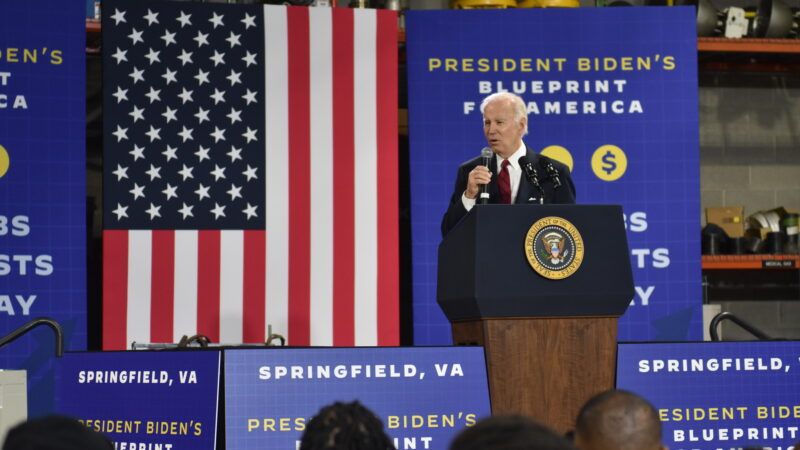The Biden Administration Flirts With Imposing Nationwide Rent Control Via Executive Action
The White House's idea of using Freddie Mac and Fannie Mae to adopt rent control faces numerous legal and practical hurdles.

Federal housing regulators are flirting with the idea of imposing nationwide rent control via executive action, although any attempt to implement their plan would run into some serious practical and legal hurdles.
On Wednesday, the White House released a Blueprint for a Renters Bill of Rights that lists a wide range of actions federal agencies are taking or considering to "strengthen tenant protections and encourage rental affordability."
The most eye-catching proposal is an announcement that the Federal Housing Finance Agency (FHFA)—the independent regulator and conservator of Freddie Mac and Fannie Mae—would explore ways it could "limit egregious rent increases" going forward at properties with a Fannie- or Freddie-backed mortgage.
Since the campaign trail, President Joe Biden has promised to create a "renters bill of rights" of federal tenant protection. In recent months, he's also been pressured by congressional Democrats and affordable housing advocates to use his executive powers to more strictly regulate "corporate landlords" and their ability to charge market prices for housing.
Both have suggested in letters to the White House that the FHFA use its powers to cap rent increases at properties with a Freddie- or Fannie-backed mortgage.
Wednesday's announcement doesn't commit the Biden administration or the FHFA to actually enacting rent control. But it does say that the independent agency will "launch a process" to consider it.
Former housing regulators and housing industry stakeholders have criticized the idea for being both counterproductive and likely illegal.
Government-sponsored enterprises (GSEs) like Fannie and Freddie "loan in places where it's often really hard to get a loan, like a small multifamily building in St. Louis," says Jim Lapides of the National Multifamily Housing Council (NMHC), a trade association.
Lapides says developers would generally just avoid taking loans that come with a rent control requirement. That means that GSEs would see their multifamily business shrink substantially. Developers in more marginal markets where GSEs are a major source of financing would struggle to get capital at all, he says.
That wouldn't necessarily be a bad outcome for people who would like to see Fannie and Freddie play a smaller role in the housing market. But enforcing rent control via the FHFA would face some serious legal hurdles.
It's "legally dubious" that the FHFA has the power to enforce rent limits, says Mark Calabria, a senior advisor to the Cato Institute and former FHFA director during the Trump administration.
Calabria says that during his tenure, the FHFA had performed a legal analysis of whether it could modify existing contracts with landlords to include additional tenant protections and rent caps, and "the conclusion was certainly you can't really do it."
The blueprint released by the White House suggests imposing limits on "egregious" rent increases on future loans only. That mirrors the demand by affordable housing groups in an August 2022 letter to the Biden administration. (In contrast, a letter authored by Sen. Elizabeth Warren (D–Mass.) and Rep. Jamaal Bowman (D–N.Y.) from earlier this month does not limit its request for FHFA-enforced rent caps to new loans.)
Calabria says that the FHFA only enforcing rent caps on new loans would remove one legal obstacle. But the policy would still have to be reconciled with the agency's statutory mission to minimize Fannie and Freddie's losses, which would be a huge stretch.
He also says that any rent control rule would face extreme internal resistance from the FHFA, Fannie, and Freddie, which would be unhappy to see their market share shrink because of the rule.
In addition to the rent control, the White House's blueprint also directs federal agencies to explore stricter regulation of tenant background checks, put more limits on evictions at public housing, restrict landlords' ability to reject federal housing vouchers, and guarantee military housing tenants' right to organize tenant unions.
The plan landed with a thud with housing providers generally. The NMHC and National Apartment Association both released statements expressing their disappointment with the plan and their opposition to an increased federal regulatory role in rental housing.
On the other side, National Low Income Housing Coalition criticized the administration for not going further in adopting its own sweeping recommendations for more tenant protections, calling the blueprint "a missed opportunity."
For all the novel regulatory interventions it's considering, the Biden administration is pretty candid that the root of renters' problems is a lack of housing supply.
"Limited housing supply has created more competition for fewer available units, which gives owners even more leverage in deciding to whom to rent to, what lease terms to offer, and whether and how much to raise rents," reads the White House's blueprint.
Rent control has a history of constricting the supply of rental housing and reducing housing quality.
By pursuing it and other policies that would raise the costs or limit the returns of providing rental housing, the White House's blueprint is likely to limit supply further and exacerbate many of the problems it's trying to fix.
Rent Free is a weekly newsletter from Christian Britschgi on urbanism and the fight for less regulation, more housing, more property rights, and more freedom in America's cities.
Show Comments (90)